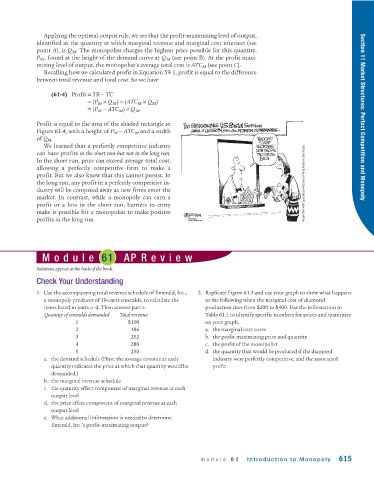Page 657 - Krugmans Economics for AP Text Book_Neat
P. 657
Applying the optimal output rule, we see that the profit-maximizing level of output,
identified as the quantity at which marginal revenue and marginal cost intersect (see
point A), is Q M . The monopolist charges the highest price possible for this quantity,
P M , found at the height of the demand curve at Q M (see point B). At the profit-maxi-
mizing level of output, the monopolist’s average total cost is ATC M (see point C).
Recalling how we calculated profit in Equation 59-1, profit is equal to the difference
between total revenue and total cost. So we have
(61-4) Profit = TR − TC
= (P M × Q M ) − (ATC M × Q M )
= (P M − ATC M ) × Q M .
Profit is equal to the area of the shaded rectangle in Section 11 Market Structures: Perfect Competition and Monopoly
Figure 61.4, with a height of P M − ATC M and a width
of Q M .
We learned that a perfectly competitive industry
can have profits in the short run but not in the long run.
In the short run, price can exceed average total cost,
allowing a perfectly competitive firm to make a
profit. But we also know that this cannot persist. In
the long run, any profit in a perfectly competitive in- Reprinted with special permission of King Feature Syndicate.
dustry will be competed away as new firms enter the
market. In contrast, while a monopoly can earn a
profit or a loss in the short run, barriers to entry
make it possible for a monopolist to make positive
profits in the long run.
Module 61 AP Review
Solutions appear at the back of the book.
Check Your Understanding
1. Use the accompanying total revenue schedule of Emerald, Inc., 2. Replicate Figure 61.3 and use your graph to show what happens
a monopoly producer of 10-carat emeralds, to calculate the to the following when the marginal cost of diamond
items listed in parts a–d. Then answer part e. production rises from $200 to $400. Use the information in
Quantity of emeralds demanded Total revenue Table 61.1 to identify specific numbers for prices and quantities
1 $100 on your graph.
2 186 a. the marginal cost curve
3 252 b. the profit-maximizing price and quantity
4 280 c. the profit of the monopolist
5 250 d. the quantity that would be produced if the diamond
a. the demand schedule (Hint: the average revenue at each industry were perfectly competitive, and the associated
quantity indicates the price at which that quantity would be profit
demanded.)
b. the marginal revenue schedule
c. the quantity effect component of marginal revenue at each
output level
d. the price effect component of marginal revenue at each
output level
e. What additional information is needed to determine
Emerald, Inc.’s profit-maximizing output?
module 61 Introduction to Monopoly 615

